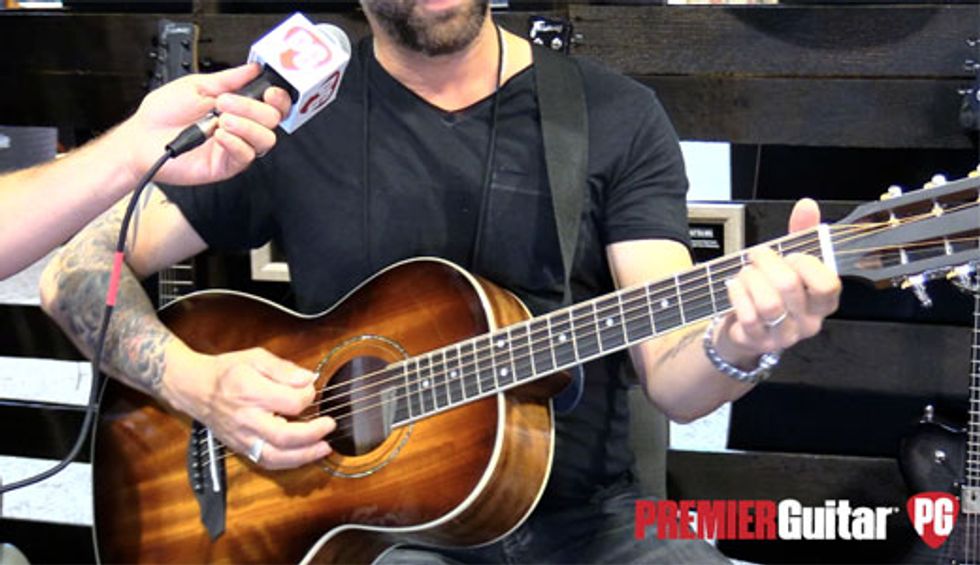Carlos O’Connell deforms his guitar with an unusual ordering of shapeshifting stompboxes, while Conor Curley embraces jangling and kerranging melodies on his hollowbody howlers. Together, they combine for a charming, chaotic chemistry.
Irish rock band Fontaines D.C. is a dual-guitar ensemble featuring Carlos O’Connell and Conor Curley. At first, the duo used similar guitars, amps, and settings in an effort to work as a symbiotic saw buzzing their way through songs. The indistinguishable incisions lacerated their earliest work with angsty piss and vinegar. But as the quintet’s musicianship has evolved, they’ve embraced wider influences, adding different knives to their collection of cutlery. And more specifically, they’ve learned when to slice, when to dice, and how to work off each other.
“I think we’re trying to be more patient and more conscious of the texture,” Curley told PG in 2022, describing how he and O’Connell have worked together to refine their sound. “The first album was very much in a fighting mode,” he continues, “with the two guitars EQ’d the same and just smashing off each other. On the second one, we learned to play together a little better. We’re still working on it, and sometimes we still try to become as one almost, when the song needs it, but I think now we’ve learned to fit in with how we’re EQing everything. It feels really good.”
Ahead of their opening slot priming crowds for the Arctic Monkeys, O’Connell and Curley invited PG’s Chris Kies onstage at the Ascend Amphitheater in downtown Nashville. Carlos covered his favored Fender solidbodies, while Conor showed off his eclectic hollowbodies, and they both walked through their respective pedalboards.Brought to you by D'Addario Trigger Capo.
A Punchy Pinger
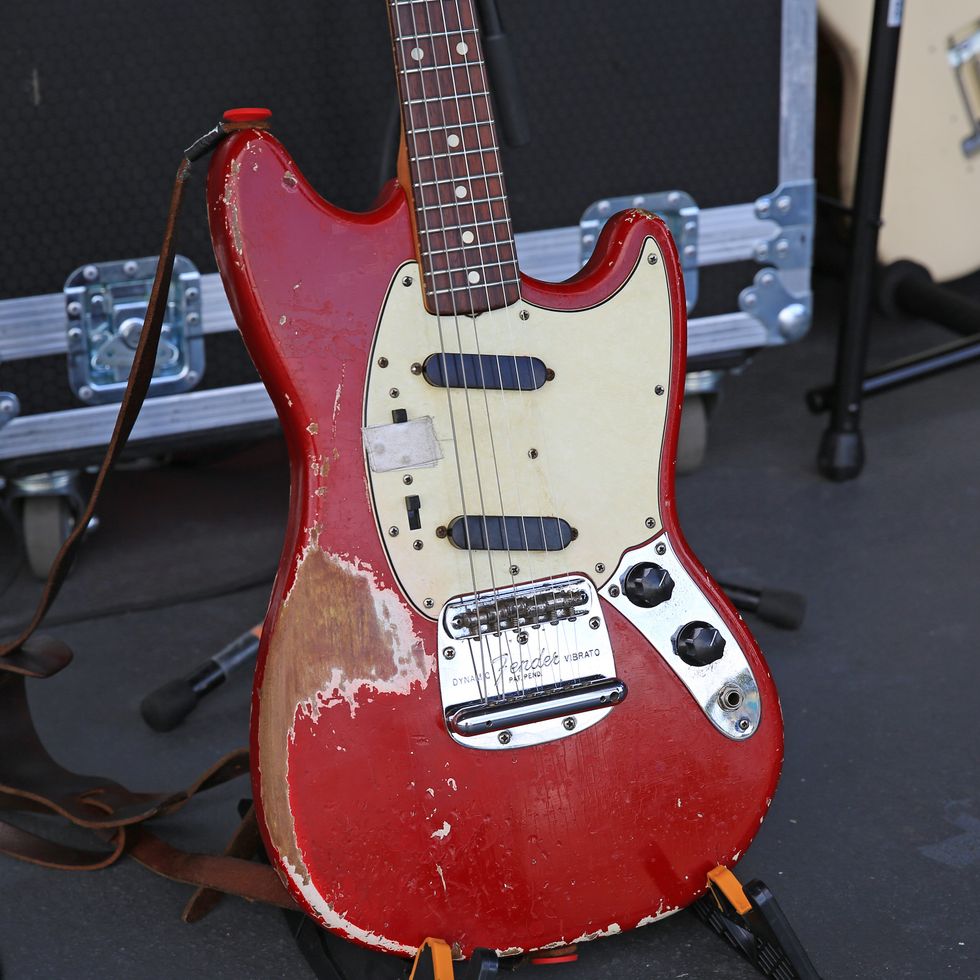
While recording with producer Dan Carey for 2022’s Skinty Fia, Carlos O’Connell fell for Carey’s mid-’60s red Fender Mustang. To replicate the album’s tones onstage, he found a similar ’Stang online. The listing originated in N.Y.C., so he had a friend at the band’s label, Partisan Records, scoop up the instrument. O’Connell was finally introduced to it before a U.S. tour, but there was something immediately wrong. The student model instrument normally came in a compact 24" scale, but a handful of ’65 & ’66 Mustangs, including this one, left Fullerton with an even shorter scale length of 22.5". O’Connell admits any guitar work handled beyond the 12th fret gets cramped, but he loves the small steed’s “snappy, pingy, high-end punch.” For a song like “Televised Mind,” he’ll engage the out-of-phase switch in conjunction with a Moose Electronics Cosmic Tremorlo. The combination intensifies the shrillness of the guitar for an undeniable sting. All of O’Connell’s electrics take Ernie Ball Burly Slinkys (.011–.052).
Irish Icon
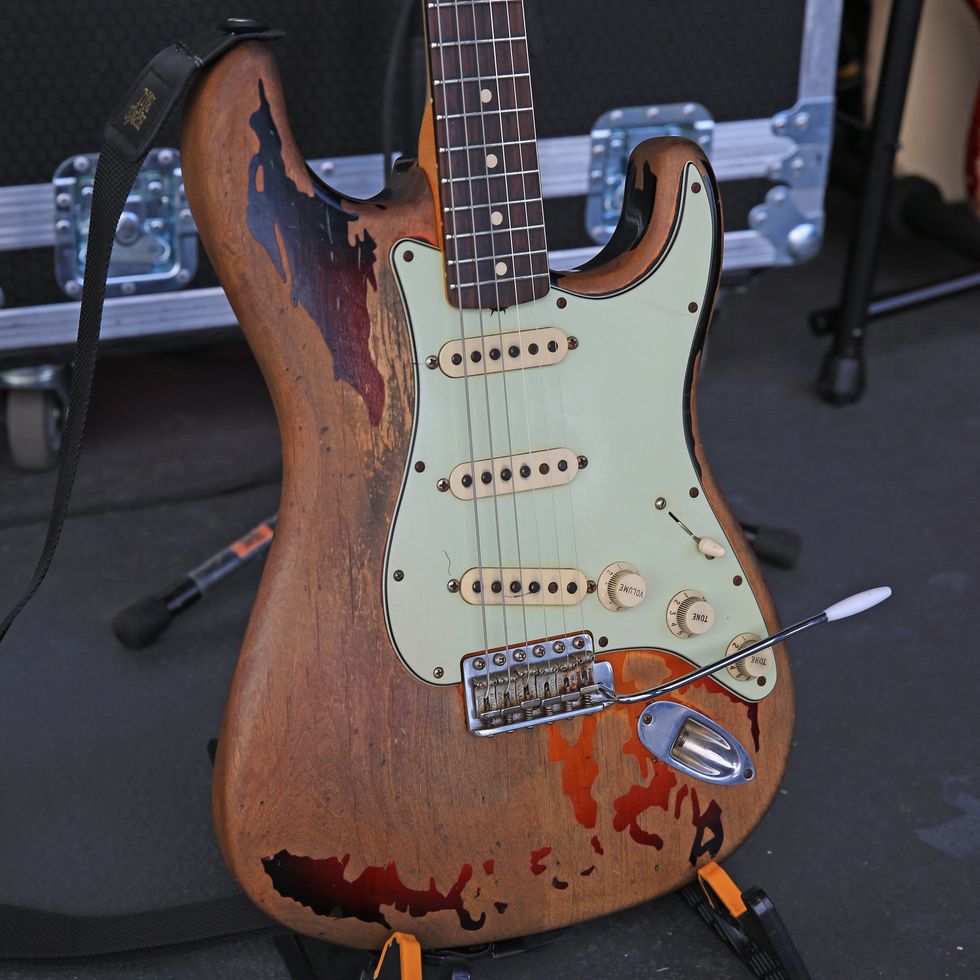
O’Connell scooped this Fender Custom Shop Rory Gallagher Signature Stratocaster with a heavy relic from Chicago Music Exchange. He wanted something to contrast the ping of the Mustang with a guitar that had a heftier, chunkier sound, which would add more low end for the band’s D-standard songs. The Strat was the perfect foil, and the replica based on Rory’s 1961 is a fitting way to honor his fellow Irishman.
Secondary Strat
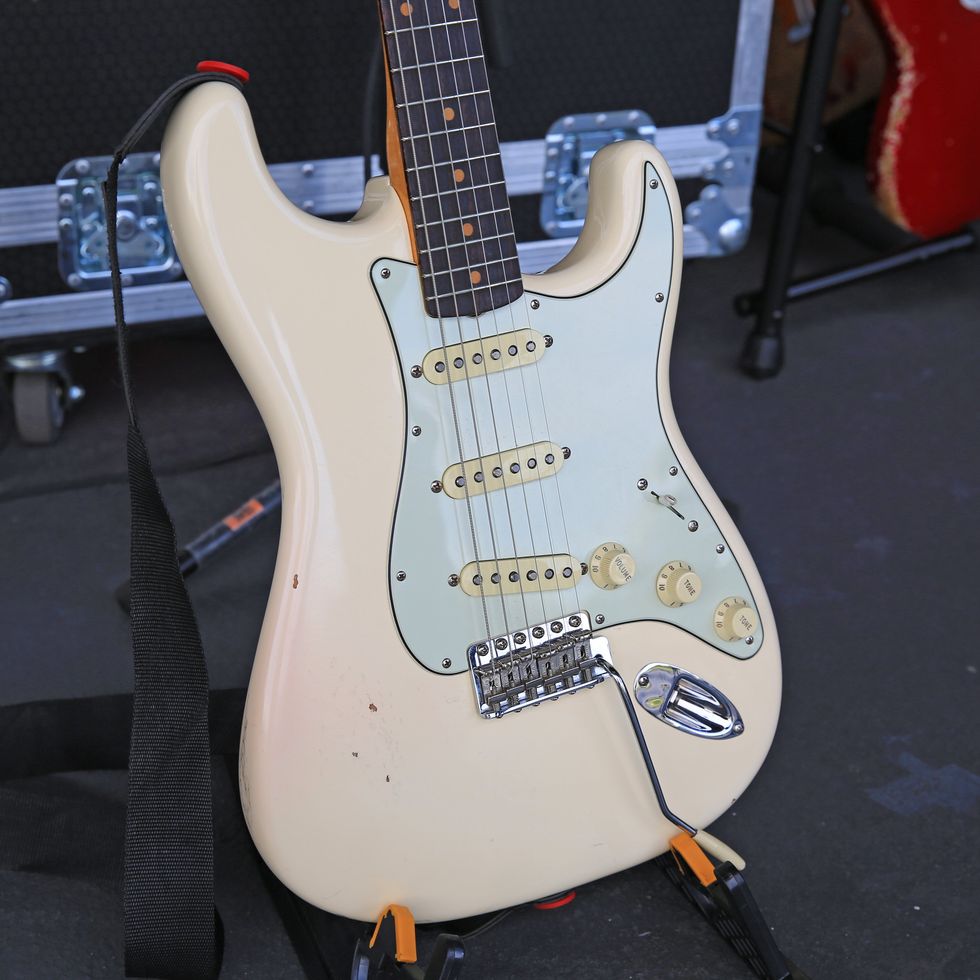
Backing up the Rory Strat is Carlos’ Fender American Vintage II 1961 Stratocaster.
Hi-Hat Chime
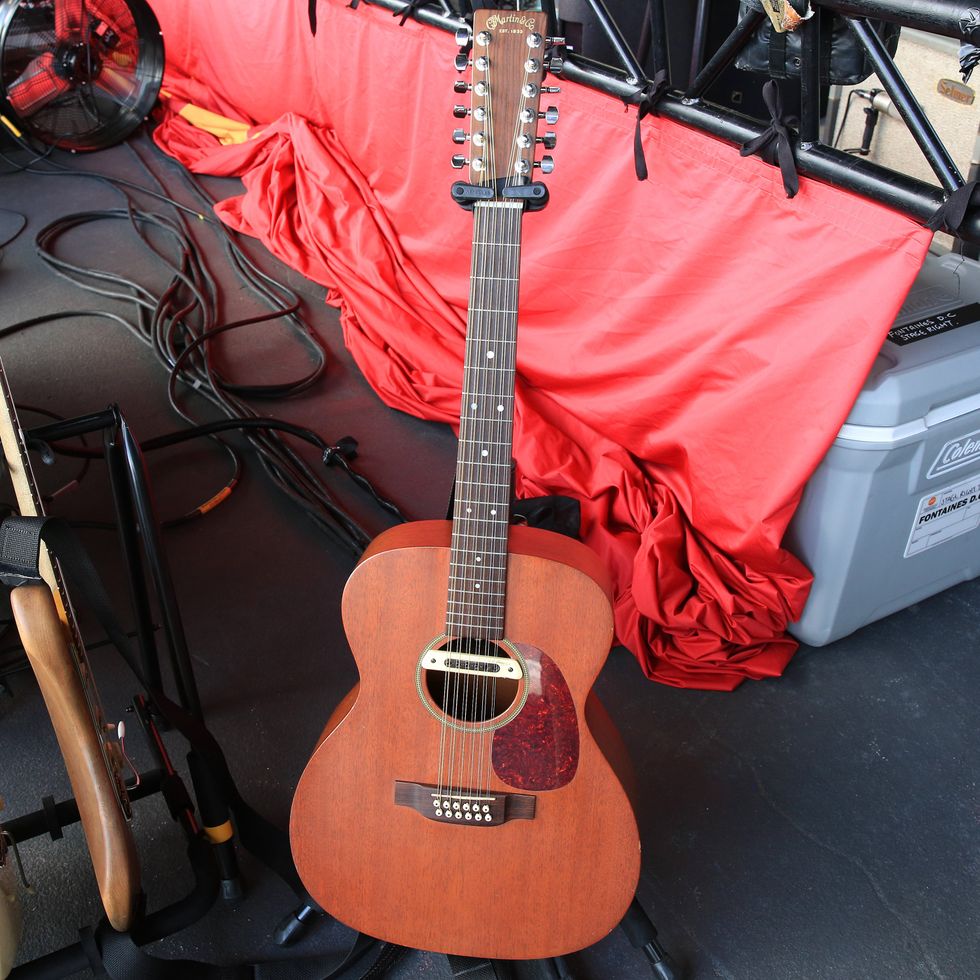
“I can’t stop thinking about the guitar as an extension of the drum kit,” explains O’Connell. “I don’t think it should exist on its own in a song. It needs to back something up—you’re either following the vocals or you’re following the drums. You can do without guitar in songs, but you can’t do without vocals or drums.” For “Roman Holiday,” he runs this Martin J12-15 Jumbo 12-String into a Fender ’68 Custom Deluxe Reverb, with a bit of extra spring splash from a reverb by Moose Electronics—which he unconventionally places first in the effects chain, ahead of his overdrives—and gain from the MXR Micro Amp that mimics the sparkly crash of hi-hats for rhythm accompaniment.
Double Trouble
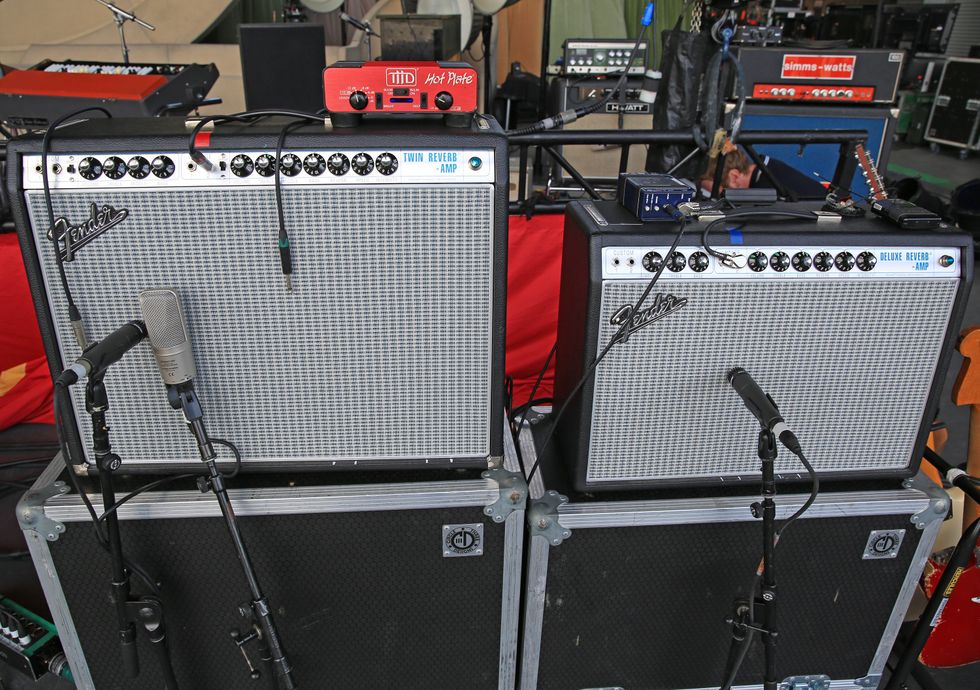
O’Connell’s core tone comes through the Fender ’68 Custom Twin Reverb. It’s always on, and he’s always plugged into the vintage channel with the bright switch engaged for primo piercing. He kicks on the ’68 Custom Deluxe Reverb for added oomph during louder bits.
Carlos O'Connell's Pedalboard
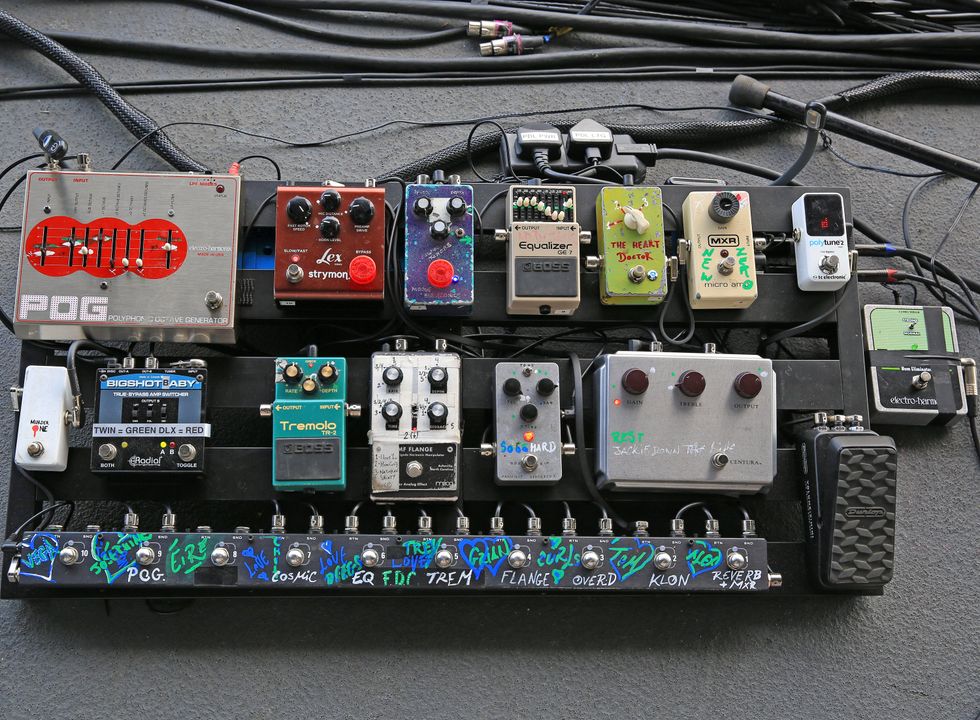
Carlos’ first pedal was the Moose Electronics reverb (The Heart Doctor). When he eventually got a distortion, he put it after the reverb. He didn’t think about it. Any other drives he got thereafter went behind the reverb. “I had no idea it was ‘wrong’ until I took my pedalboard into the studio, and they told me I had to rearrange them because the reverb was too dirty, but I like how it sounds like a snare in a huge room,” admits O’Connell. And the rest of his pedal pals follow the same mantra—anything wrong is right, and anything grotesque is gorgeous.
Dirty devils include a Ceriatone Centura, a Fairfield Circuitry The Barbershop Millennium Overdrive, and an MXR Micro Amp. Tone-twisting modulators include a Moog Minifooger MF Flange, a Boss TR-2 Tremolo, a Strymon Lex, a Moose Electronics Cosmo Tremorlo, and an Electro-Harmonix POG. A Boss GE-7 Equalizer helps shape his sound. Utility boxes in his setup are the Radial BigShot ABY True Bypass Switcher (toggling in and out the ’68 Custom Deluxe Reverb), a TC Electronic PolyTune 2 Mini, a Dunlop Volume (X) DVP4, and an Electro-Harmonix Hum Debugger. A TheGigRig QuarterMaster QMX handles all the switching.
Holiday Hollowbody
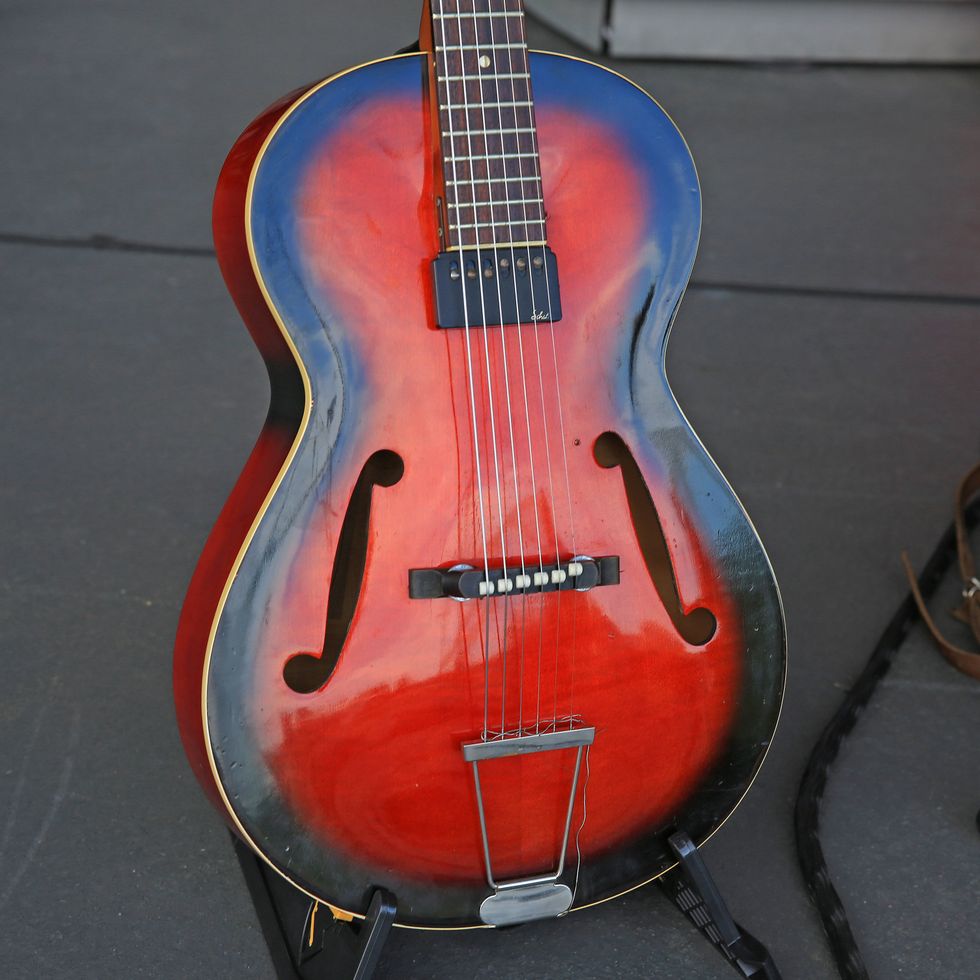
While taking a break from Fontaines D.C., guitarist Conor Curley enjoyed some downtime in Berlin. Luckily, he encountered this 1960s Framus 03000 Studio that he took home for roughly $250. The archtop already had the Schaller pickup installed at the end of the fretboard, and he was amazed how well it meshed with distortion: “It just sounded so chubby and big.” He strings the Studio—which gets used on “How Cold Love Is”—with flatwounds.
Key Weapon
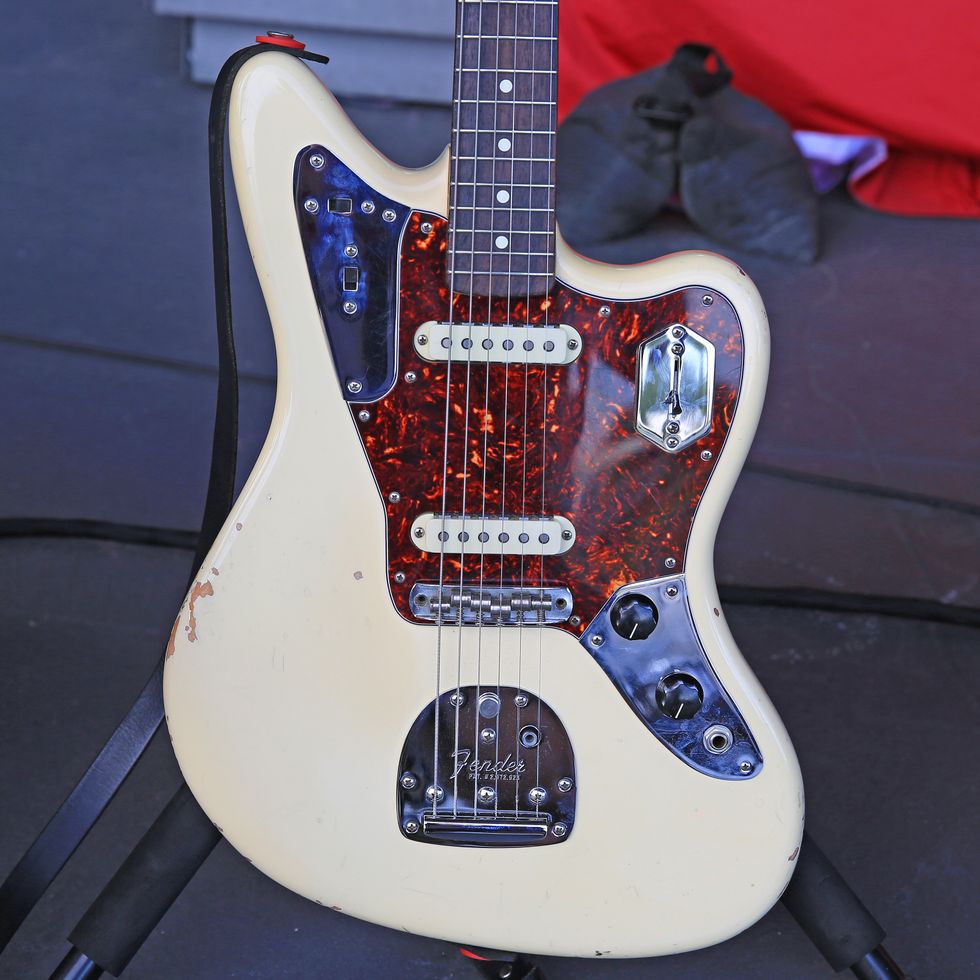
Curley’s two favorite guitarists are Johnny Marr and the Birthday Party’s Rowland S. Howard. Both played Jaguars, so Curley’s gravitation to the offset was obvious. Since becoming friendly with this Fender Johnny Marr Jag, he’s appreciated the versatility of its series and parallel switching. To honor Howard, he swapped out the standard white pickguard for a tortoiseshell one that matches Rowland’s beloved 1966 Jag. Besides the Framus, all of Curley’s electrics take Ernie Ball Burly Slinkys (.011–.052).
Some Neck, Somewhere
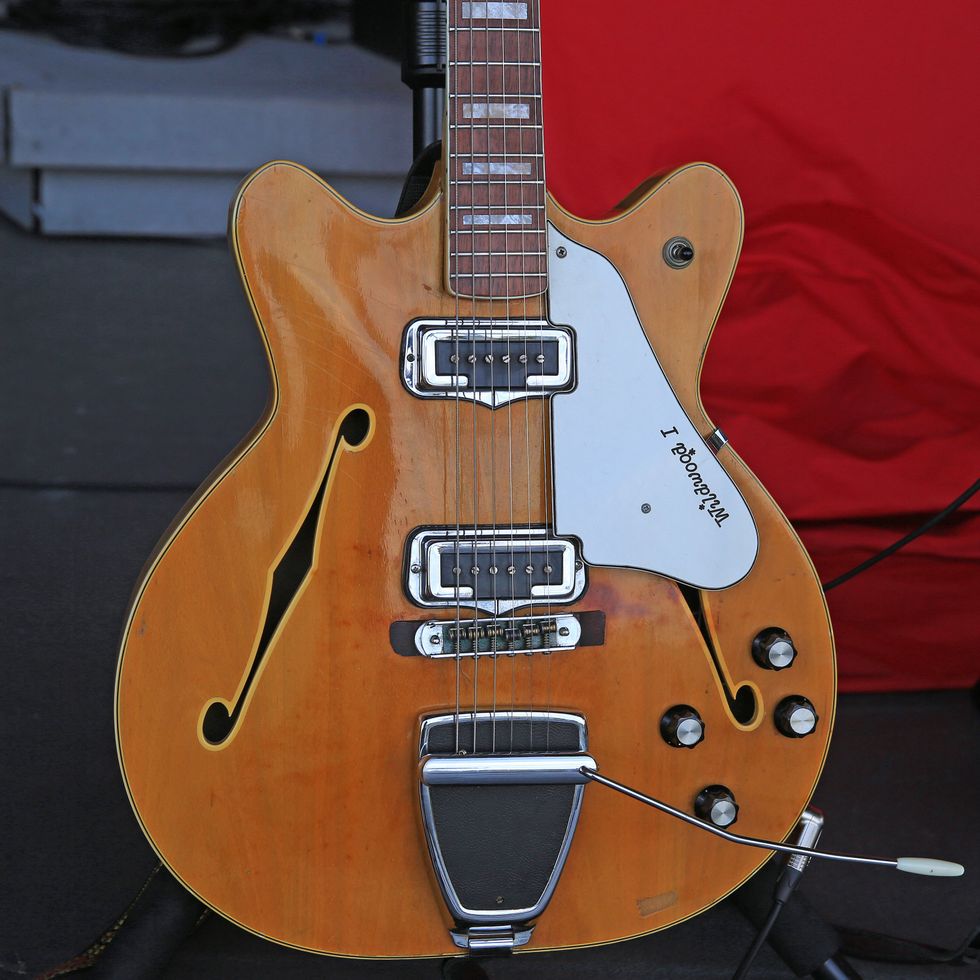
Ahead of recording their sophomore album, A Hero’s Death, Curley decided to splurge his cut of the record’s advance on a vintage guitar. At Dublin’s Some Neck Guitars, he purchased his first Fender Coronado—his attempt to channel the haunting hollowbody tones of the Brian Jonestown Massacre and the Black Angels. Since then, he’s acquired a few more Coronados, and his main touring one is this late-’60s Fender Coronado II Wildwood model he found in Stoke-on-Trent. His goal, one day, is to have a room full of Coronados. Godspeed, Curley!
Clint Eastman
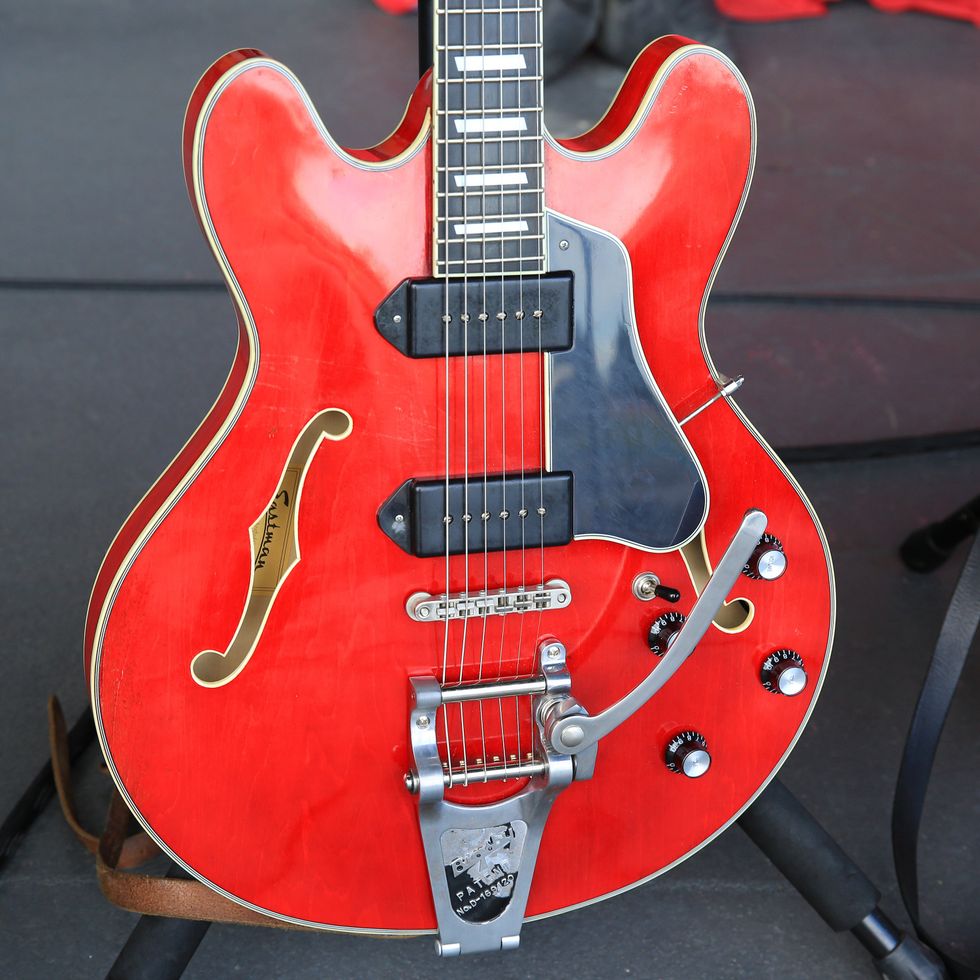
At one point, Curley was diving deep into Elliott Smith’s electric playing. Smith typically played a Gibson ES-330, but Curley didn’t want to dip into his Coronado money to get an ES, so he opted for this similar Eastman T64/v that shares a lot of the 330’s ingredients, including a 16" thinline hollowbody construction with laminated maple, 24.75" scale length, and dog-ear P-90s (Lollar).
Twin for the Win
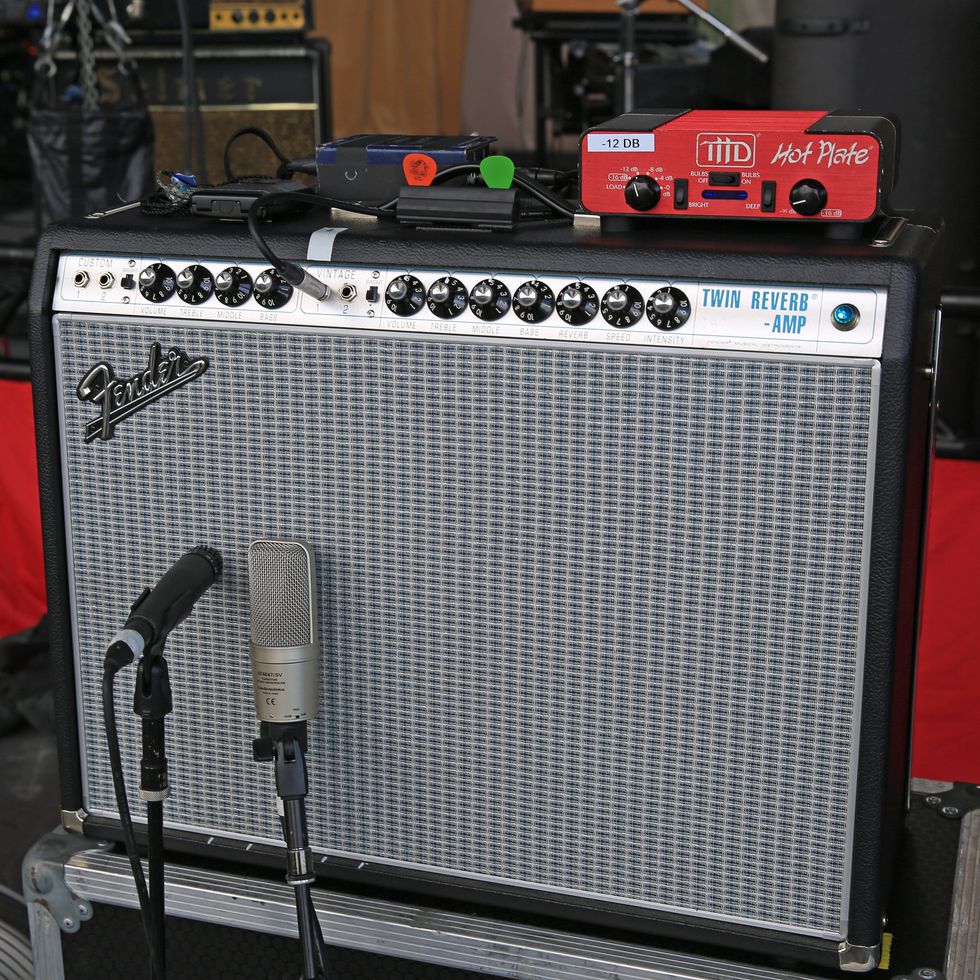
Curley plugs all his instruments into this Fender ’68 Custom Twin Reverb because “they don’t flavor anything. They let your guitars sound like your guitars, and they let the pedals do what they need to do.”
Experimentation Station
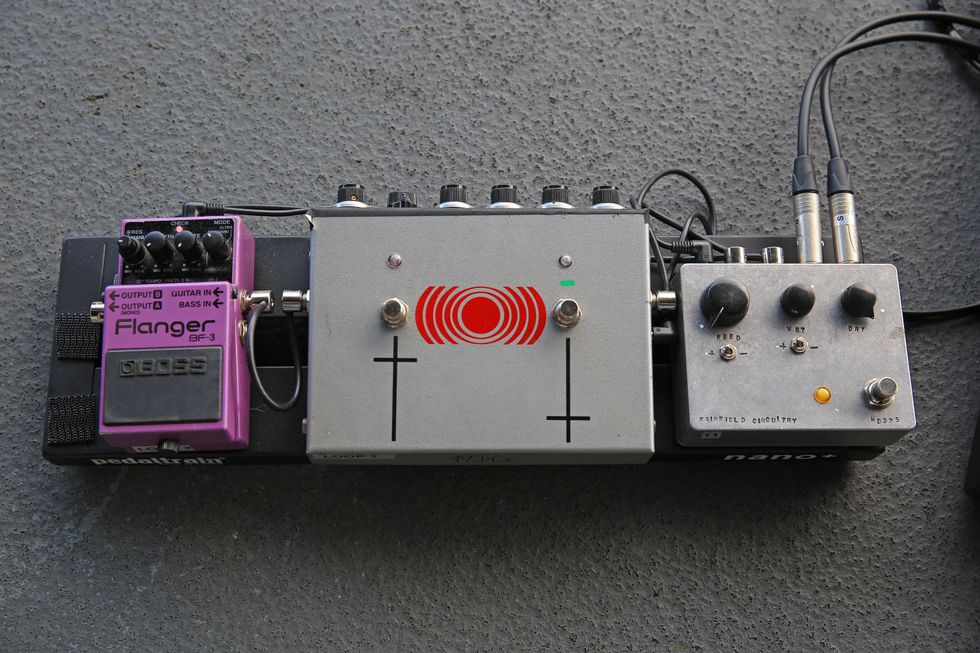
Curley has a robust appetite for pedals. This small platter is his rotating appetizer board that is currently testing out a Boss BF-3 Flanger, an EarthQuaker Devices Sunn O))) Life Pedal, and a Fairfield Circuitry Hors d’Oeuvre? active feedback loop.
Conor Curley's Pedalboard
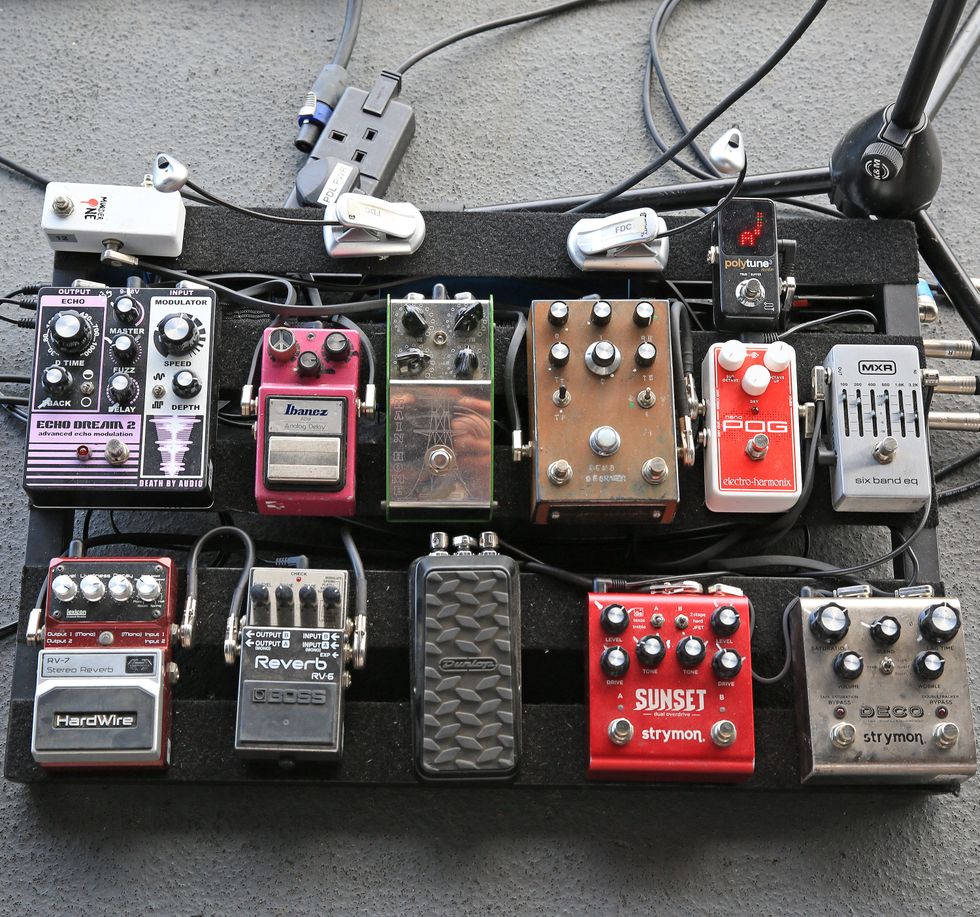
“There were definitely a lot more shoegazey elements that we were trying to get to, and, obviously, if you start talking about Kevin Shields or even Robin Guthrie from Cocteau Twins, the stuff they did, to me, is almost unreachable, but if you try, you might end up with something new anyway,” Curley confessed to PG last year. And to achieve the range of the more ethereal and atmospheric sounds heard on Skinty Fia as well as the more brutish garage bangers in their earlier work requires a buffet of boxes. Curley employs three delays: Death By Audio Echo Dream 2, Ibanez AD9 Analog Delay, and the Industrialectric Echo Degrader. The latter “is so unpredictable, it’s almost like it doesn’t sound the same every time you use it.” He has a pair of reverbs (DigiTech HardWire RV-7 Stereo Reverb and a Boss RV-6 Reverb) and a couple Strymons (Sunset Dual Overdrive and Deco Tape Saturation & Doubletracker). The remaining three devices are a ThorpyFX Chain Home Tremolo, an Electro-Harmonix Micro POG, and a MXR Six Band EQ. A Dunlop Volume (X) DVP4 handles dynamics, and a TC Electronic PolyTune 3 Noir Mini keeps his guitars in check.
Shop Fontaines D.C.'s Rig
 Shop Scott's Rig
Shop Scott's RigFender Mustang
Fender Rory Gallagher Stratocaster
Fender American Professional Stratocaster
Fender American Vintage II 1961 Stratocaster
Fender Johnny Marr Jaguar
Ernie Ball Burly Slinkys
Fender '68 Custom Twin Reverb
Fender '68 Custom Deluxe Reverb
EarthQuaker Devices Sunn O))) Life Pedal
Boss BF-3 Flanger
Boss RV-6 Reverb
EHX Micro POG
TC Electronic PolyTune3
MXR Six Band EQ
Strymon Deco
Strymon Sunset
Dunlop Volume (X) DVP4
EHX POG
Strymon Lex
Radial Bigshot ABY
Boss TR-2 Tremolo
Boss GE-7 Equalizer
MXR Micro Amp
EHX Hum Debugger
The current lineup of Alice in Chains has hit a stride on its third album together, Rainier Fog. From left to right: guitarist/vocalist William DuVall, drummer Sean Kinney, guitarist/vocalist Jerry Cantrell, and bassist Mike Inez.
Jerry Cantrell and William DuVall embrace the past and move forward on Rainier Fog, the guitarists’ third album together and a fitting tribute to Emerald City.
It's been five long years without a release from Alice in Chains. And with harder music disappearing from the airwaves, rock 'n' roll was desperate for their return. Well, return they have. Rainier Fog, the band's latest offering of haunting harmonies, pummeling guitar work, and dark imagery, is sure to instantly grab the attention of all AIC fans. But the band's new-found ability to embrace their past with a triumphant look forward separates this album from anything in their lauded catalog.
As this incarnation of the band—guitarist/vocalist Jerry Cantrell, guitarist/vocalist William DuVall, bassist Mike Inez, and drummer Sean Kinney—drops their third full-length album, it's hard to believe they've been together longer than any of the band's previous lineups. And in fact, Cantrell and DuVall were actually sowing the seeds years prior.
As part of Cantrell's touring solo band in the early 2000s, DuVall had all the opportunity he needed to learn the ins and outs of Cantrell and the late Layne Staley's unique sound. “2001 and 2002 were heavy groundwork years," DuVall says. “Everything happening now is a result of that."
But it wasn't an easy road getting to now. Throughout the band's career, it has been infamously plagued by addiction, the passing of bandmates [original frontman Staley in 2002 and original bassist Mike Starr in 2011], and the loss of friends and notable musicians who shared the '90s spotlight on Seattle.
It's a history that weighed particularly heavy on Rainier Fog. “I was thinking about Chris Cornell who had just passed the month before," laments DuVall. “Of course, I was also thinking about Layne Staley. And of course, I was thinking about Cobain."
But times do change, and wounds do begin to heal. And for what may be the first time, the rays of hope and celebration are able to cut through the cement-thick grooves and minor-key dirges that fill Rainier Fog. It's hope and celebration that comes from confronting the band's ties to the Emerald City, the pain brought by years of loss, and most importantly, the victory and hallowed place in rock history that AIC and their fellow Seattle rockers share.
“There was a lot of looking toward home, and it wasn't in any sort of bummer or negative way," Cantrell explains. “It's just that we're a Seattle band. It's where we fucking started and it's still who we are. We're really proud to be part of the history of our town."
That pride in their hometown is why the band chose to track much of Rainier Fog at Studio X in Seattle, the same studio the band recorded their last full-length with their legendary original frontman. And the band was meticulous in taking their time to get it right. They even brought back Nick Raskulinecz, the man behind the desk for the band's successful Black Gives Way to Blue (2009) and The Devil Put Dinosaurs Here (2013). One listen through punishingly heavy tracks such as “Red Giant" and the album's second single, “So Far Under," as well as the band's trademark acoustic-driven tracks like “Maybe," and it's clear the effort has been fruitful.
Fresh off a European leg of a tour supporting the new album, Cantrell and DuVall took time to speak to Premier Guitar about what it means to be in Alice in Chains today. From waxing ecstatic about their own signature guitars and amplifiers to illustrating how the spirit of Seattle remains the fifth member of the band, it's clear both guitarists still carry a passion for their music while embracing their past and future more readily than ever.
Rainier Fog mates elements of classic Alice in Chains with new sonic twists. Were you focused on having such a broad reach?
Jerry Cantrell: There's not really a plan ahead of time on where we're going. It's just that we're starting a journey, and we don't know where it's going to end. Wherever it ends up, that's what the record's going to be. I think that's a hallmark of this band, that we don't know where the fuck we're going [laughs]. But we know we're going to get somewhere. And if we didn't get there, you wouldn't hear it [laughs].
Will, this is your third album with the band. What do you think you bring to the classic Alice in Chains sound?
William DuVall: It's just myself. Even if I write something I know those guys will respond to, like I wrote “So Far Under" on the new album and the lyrics to “Never Fade," and a song like “Last of My Kind" on the Black Gives Way to Blue album, or the riffs I wrote for “A Looking in View" and “Phantom Limb," those are all things that, even if it's being adapted to the certain sonic signature of this band, it's still me.
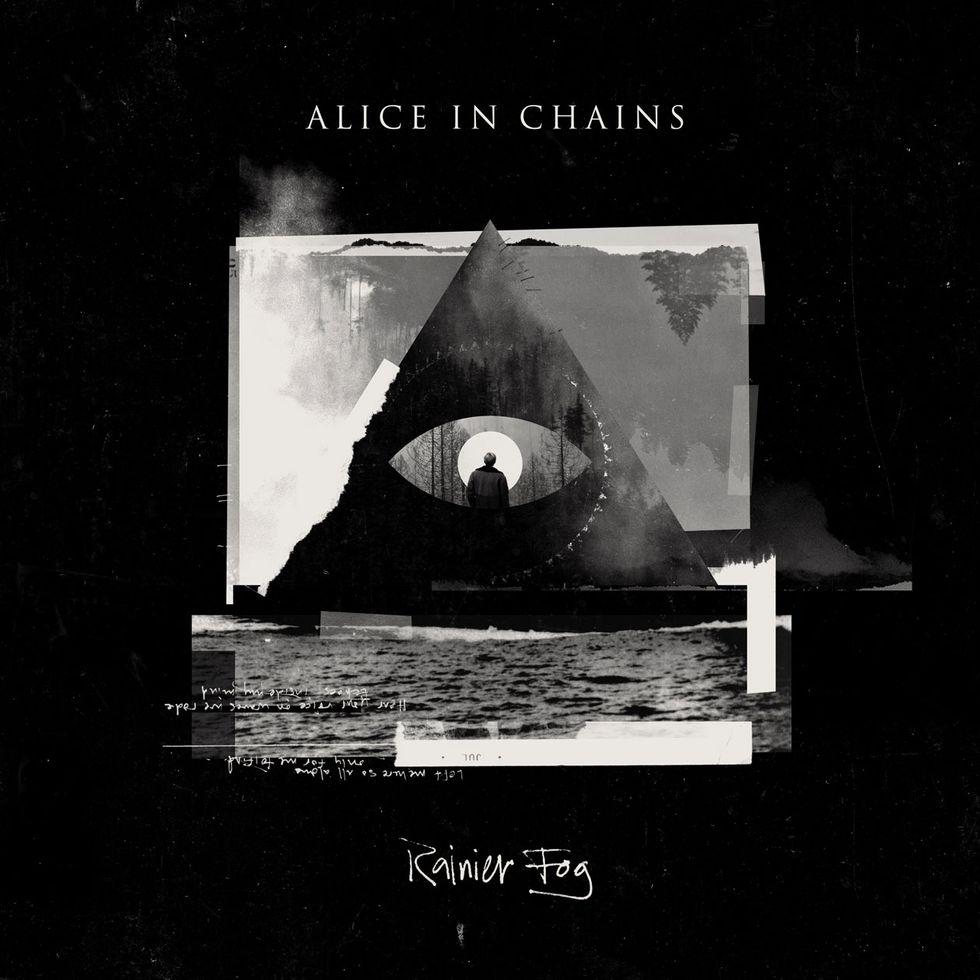
Alice in Chains recorded Rainier Fog in Seattle's Studio X, the same studio the band used to record its 1995 self-titled album. They enlisted Nick Raskulinecz, who produced the previous two AIC studio albums in 2013 and 2009.
Cantrell: He always comes up with some really important stuff for each record, just like all of us do, “So Far Under" in particular. From “It Ain't Like That" [Facelift] on, there's always a song or two that's based on a weird, bendy riff. On the last couple records, there was “Stone" and “Check My Brain." But on this one, I didn't write one of those. And the funny part is that the signature bendy Alice-type song, Will wrote this time. And that's cool because Layne did the same thing with “Hate to Feel" and “Angry Chair." So it's a tradition, and it means he's really in there.
Another one of those signature Alice in Chains elements is the way you work acoustic guitars into your songs and arrangements. What is it that appeals to you about the heavy and acoustic juxtaposition?
Cantrell: I've actually been talking a lot about this recently, about the importance of that Sap EP. The importance of putting that EP out immediately following a really successful record [Facelift] that put us on the map. And it was the only record we had, so that's what people identified us as. It was a gamble. But by doing that, it set a tradition for us and opened up the playing field of, “We can do whatever the fuck we want. We don't just have to be a fucking heavy band all the time." You could even make the argument that some of the heavier shit we've done is the acoustic-based stuff. “Nutshell" has just as much weight as “Them Bones."




